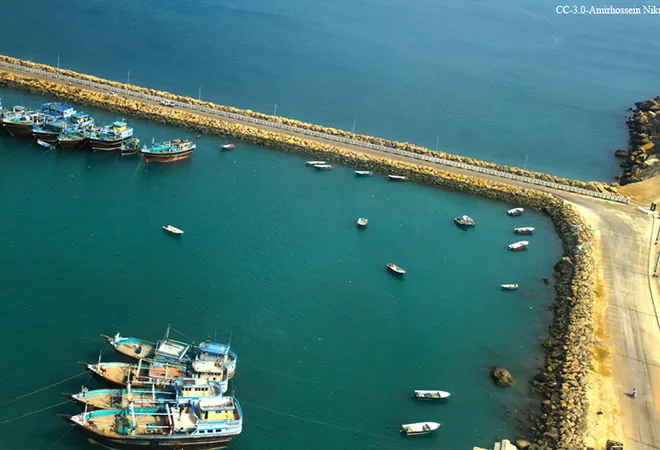New Delhi now ought to prove its logistical capabilities in accomplishing the full potential of the port to maintain its credibility in the global connectivity realpolitik.
India’s long-awaited proposal to establish a trade route with landlocked Afghanistan and former Soviet republics in Central Asia and Europe through an alternative land-sea route conveyance was realised with the India-Iran-Afghanistan trilateral and the India-Iran bilateral agreements inked in May 2016. The agreements signed on the sidelines of Indian Prime Minister Narendra Modi’s historic visit to Tehran, a first such visit by serving PM after Atal Bihari Vajpayee’s visit in 2001. While the trilateral agreement entails New Delhi’s participation in the development of two berths with capital investment of $85 million, the bilateral agreement involving the India Ports Global Private Limited (IPGPL) and Iran’s Arya Banader engages New Delhi to develop and operate two terminals and five berths for ten years, following a 18-month lease, at Shahid Beheshti Port in Chabahar of Sistan and Baluchestan province in Southeastern Iran. The bilateral agreement also allocates a $150 million line of credit for the development of the port, while an additional $500 million credit is made available for Iran to import rail tracks and operationalise the port. Also, the MoU between Indian Railway Construction Limited (IRCON) and Tehran’s Construction, Development of Transport and Infrastructure Company (CDTIC) to establish a rail network between Chabahar and the capital of Sistan and Baluchestan Province, Zahedan, facilitates credit of over $1.6 billion.
Despite the modest financial allocations, phase one of the port is underutilised at 10 per cent of the total capacity due to broader geopolitical tensions, which primarily includes President Donald Trump’s sanctions against Iran.
In December 2017, Iranian President Hassan Rouhani inaugurated the Phase One of the Shahid Beheshti Port’s five-phase development plan, which expanded the port capacity from 2.5 million tonnes to 8.5 million tonnes at the cost of $1 billion. Despite the modest financial allocations, phase one of the port is underutilised at 10 per cent of the total capacity due to broader geopolitical tensions, which primarily includes President Donald Trump’s sanctions against Iran. Against such a backdrop, Shahid Beheshti Port is gaining renewed potential following New Delhi and Tehran’s diplomatic, industrial and economic policy decisions.
India’s revamped interests
The developments in bilateral relations, including Indian Minister of External Affairs Subrahmanyam Jaishankar’s visit to Tehran for 19th India-Iran Joint Commission Meeting, his Iranian counterpart Javad Zarif’s visit to New Delhi for ORF’s Raisina Dialogue and essentially the India Union Budget for 2020-21 fiscal, demonstrates a series of proactive measures aimed at promoting the India-Iran mutual interests in the development of the Shahid Beheshti Port. While the two high-ranking leaders expressed their intent to expedite the development and fully operationalise the port in Chabahar, Indian Ministry of External Affairs (MEA) earmarked $13.9 million in fiscal 2020-21, which constitutes 0.5 per cent of the MEA budget, for the development of the port. Although MEA allotted funds for the port in all the fiscal budgets since 2016-17, the latest budget allocation gains greater geopolitical significance, following the heightened US-Iran tensions over the killing of Iranian General Qasem Soleimani. In addition to doubling the allocation from the previous fiscal of $6.25 million, the Indian ambassador to Iran floating an idea of India-Iran Preferential Trade Agreement (PTA), at a time when the country is under US’s sanctions, demonstrates New Delhi’s financial as well as political determination to develop the port as a viable alternative connectivity to Afghanistan and also boost bilateral trade relations.
Although MEA allotted funds for the port in all the fiscal budgets since 2016-17, the latest budget allocation gains greater geopolitical significance, following the heightened US-Iran tensions over the killing of Iranian General Qasem Soleimani.
While many experts lament over the slow pace of operationalisation of the port, high-ranking officials in Tehran undoubtedly hold that New Delhi’s participation is the sine qua non to avail conditional waivers against the Trump’s sanctions. Similar waivers were inconceivable, should China or Russia have engaged in the port development. Besides, the potential exponential growth in trade and commerce between India and landlocked Afghanistan and Central Asian Republics is quintessential for the economic sustainability of the project.
New Delhi self-defines interests
The existence of an “accommodative bargaining” equation in India-US relations prompted New Delhi to invest a multi-aligned diplomatic approach with the US to garner formal exemptions for Shahid Beheshti Port in Chabahar at the US-India 2+2 Dialogue in December last year. Despite the earlier asserted exemptions in 2018, New Delhi’s posture to seek the written assurance demonstrates its political and diplomatic reliability, which further informs the likely acceleration in equipping the port with heavy machinery and tools required to handle the cargo. The lack of waivers defeats Tehran’s objective to infuse socio-economic and infrastructure development in the less developed southeastern region. The same also defeats the objective to expand the prosperity through port infrastructure-led development, which will further bring stability and peace in the restive Sistan and Baluchestan area. Here, any realist policymaker in Tehran should quell the prospects of China and Russia joining the port project, at least in the immediate term. With approving conditional exemptions on the India-led Chabahar entity, the US has strengthened New Delhi’s hands to balance China’s presence in the Indo-Pacific region.
Any realist policymaker in Tehran should quell the prospects of China and Russia joining the port project, at least in the immediate term.
Multiple projects in Iran are overshadowed by the consequences of the sanctions, as international entities, including European firms, have been flinching from investments in Iran. In such a context, India’s political reliability and financial commitment and diplomatic will only strengthen New Delhi’s intent to maintain strategic autonomy and self-define its relations with Iran and its interests in Chabahar, even in the face of the prevailing US government and its sanctions. The Indian posture imperatively implies that Trump’s sanctions never hindered New Delhi to deliver on its commitments to develop the port, but those very sanctions flinched European and Chinese firms to deliver heavy machinery to equip the port. India’s unhindered commitment towards the project was manifested in its continuity in budget allocations in all fiscals since 2016-17. Such a defining nature will prompt India to pursue a mutually prosperous and progressive relationship with Iran over the coming years as New Delhi prioritises its connectivity initiatives in West Asia as well as the strategic advantage in the northwestern Indian Ocean Region (IOR).
Wider prospects
Despite steadfastly sticking to its commitment, New Delhi now ought to prove its logistical capabilities in accomplishing the full potential of the port in an attempt to maintain its credibility in the global connectivity realpolitik. Apart from circumventing Pakistan, the success of the Chabahar plausibly weakens the commercial and economic viability of the China Overseas Port Holding Company (COPHC)-owned Gwadar Port, which is protruded as the key feature of the China-Pakistan Economic Corridor (CPEC), China’s flagship project under the President Xi Jinping’s ambitious Belt and Road Initiative (BRI). Besides, a successful Chabahar buttresses India as a viable alternative against the giant shipbuilding and port building nations in the region and extended neighbourhood, particularly in Africa. In the immediate term, New Delhi should burnish its multi-alignment credentials to absorb investments into the port project from the public and private sector, boost maritime cooperation among IOR countries to enhance the transit of goods, and foster regional partnerships for the Chabahar port. Based on the similarities in energy demand and geopolitical interest, New Delhi should explore all possible opportunities to collaborate with Japan under the Asia-Africa Growth Corridor. Japan’s participation will boost the multilateral characteristics of the transit hub in the region, unlike the COPHC-owned Gwadar port, which will further entice multilateral investments to solidify regional economic partnerships that proliferates the sustainability factor of the port.












